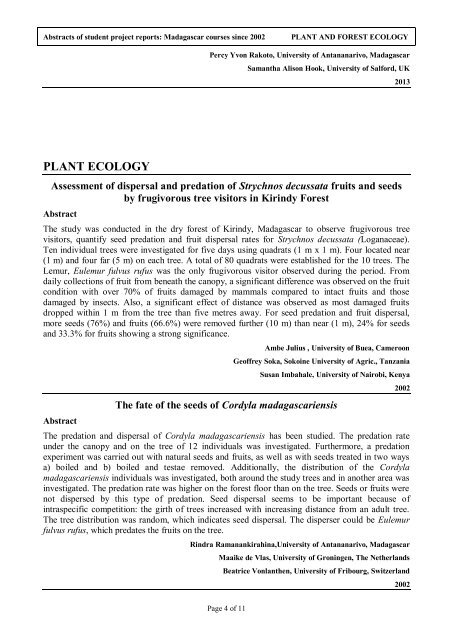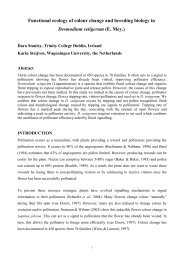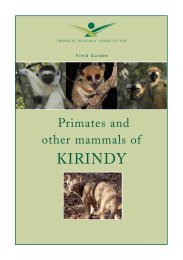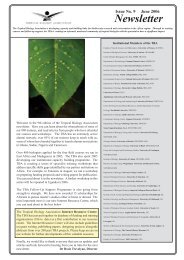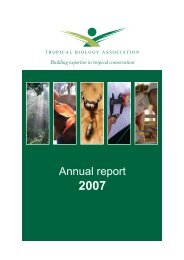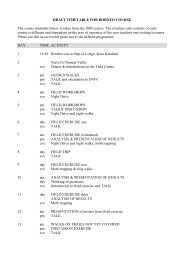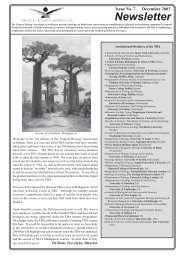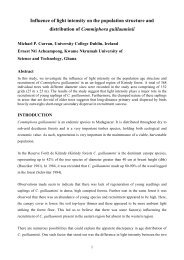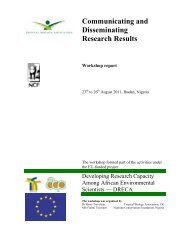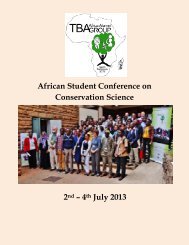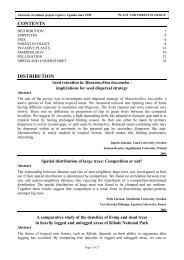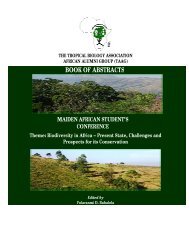Plant and forest ecology - Tropical Biology Association
Plant and forest ecology - Tropical Biology Association
Plant and forest ecology - Tropical Biology Association
Create successful ePaper yourself
Turn your PDF publications into a flip-book with our unique Google optimized e-Paper software.
Abstracts of student project reports: Madagascar courses since 2002<br />
PLANT AND FOREST ECOLOGY<br />
Percy Yvon Rakoto, University of Antananarivo, Madagascar<br />
Samantha Alison Hook, University of Salford, UK<br />
2013<br />
PLANT ECOLOGY<br />
Assessment of dispersal <strong>and</strong> predation of Strychnos decussata fruits <strong>and</strong> seeds<br />
by frugivorous tree visitors in Kirindy Forest<br />
Abstract<br />
The study was conducted in the dry <strong>forest</strong> of Kirindy, Madagascar to observe frugivorous tree<br />
visitors, quantify seed predation <strong>and</strong> fruit dispersal rates for Strychnos decussata (Loganaceae).<br />
Ten individual trees were investigated for five days using quadrats (1 m x 1 m). Four located near<br />
(1 m) <strong>and</strong> four far (5 m) on each tree. A total of 80 quadrats were established for the 10 trees. The<br />
Lemur, Eulemur fulvus rufus was the only frugivorous visitor observed during the period. From<br />
daily collections of fruit from beneath the canopy, a significant difference was observed on the fruit<br />
condition with over 70% of fruits damaged by mammals compared to intact fruits <strong>and</strong> those<br />
damaged by insects. Also, a significant effect of distance was observed as most damaged fruits<br />
dropped within 1 m from the tree than five metres away. For seed predation <strong>and</strong> fruit dispersal,<br />
more seeds (76%) <strong>and</strong> fruits (66.6%) were removed further (10 m) than near (1 m), 24% for seeds<br />
<strong>and</strong> 33.3% for fruits showing a strong significance.<br />
Abstract<br />
Ambe Julius , University of Buea, Cameroon<br />
Geoffrey Soka, Sokoine University of Agric., Tanzania<br />
Susan Imbahale, University of Nairobi, Kenya<br />
The fate of the seeds of Cordyla madagascariensis<br />
The predation <strong>and</strong> dispersal of Cordyla madagascariensis has been studied. The predation rate<br />
under the canopy <strong>and</strong> on the tree of 12 individuals was investigated. Furthermore, a predation<br />
experiment was carried out with natural seeds <strong>and</strong> fruits, as well as with seeds treated in two ways<br />
a) boiled <strong>and</strong> b) boiled <strong>and</strong> testae removed. Additionally, the distribution of the Cordyla<br />
madagascariensis individuals was investigated, both around the study trees <strong>and</strong> in another area was<br />
investigated. The predation rate was higher on the <strong>forest</strong> floor than on the tree. Seeds or fruits were<br />
not dispersed by this type of predation. Seed dispersal seems to be important because of<br />
intraspecific competition: the girth of trees increased with increasing distance from an adult tree.<br />
The tree distribution was r<strong>and</strong>om, which indicates seed dispersal. The disperser could be Eulemur<br />
fulvus rufus, which predates the fruits on the tree.<br />
2002<br />
Rindra Ramanankirahina,University of Antananarivo, Madagascar<br />
Maaike de Vlas, University of Groningen, The Netherl<strong>and</strong>s<br />
Beatrice Vonlanthen, University of Fribourg, Switzerl<strong>and</strong><br />
2002<br />
Page 4 of 11


